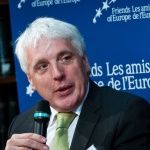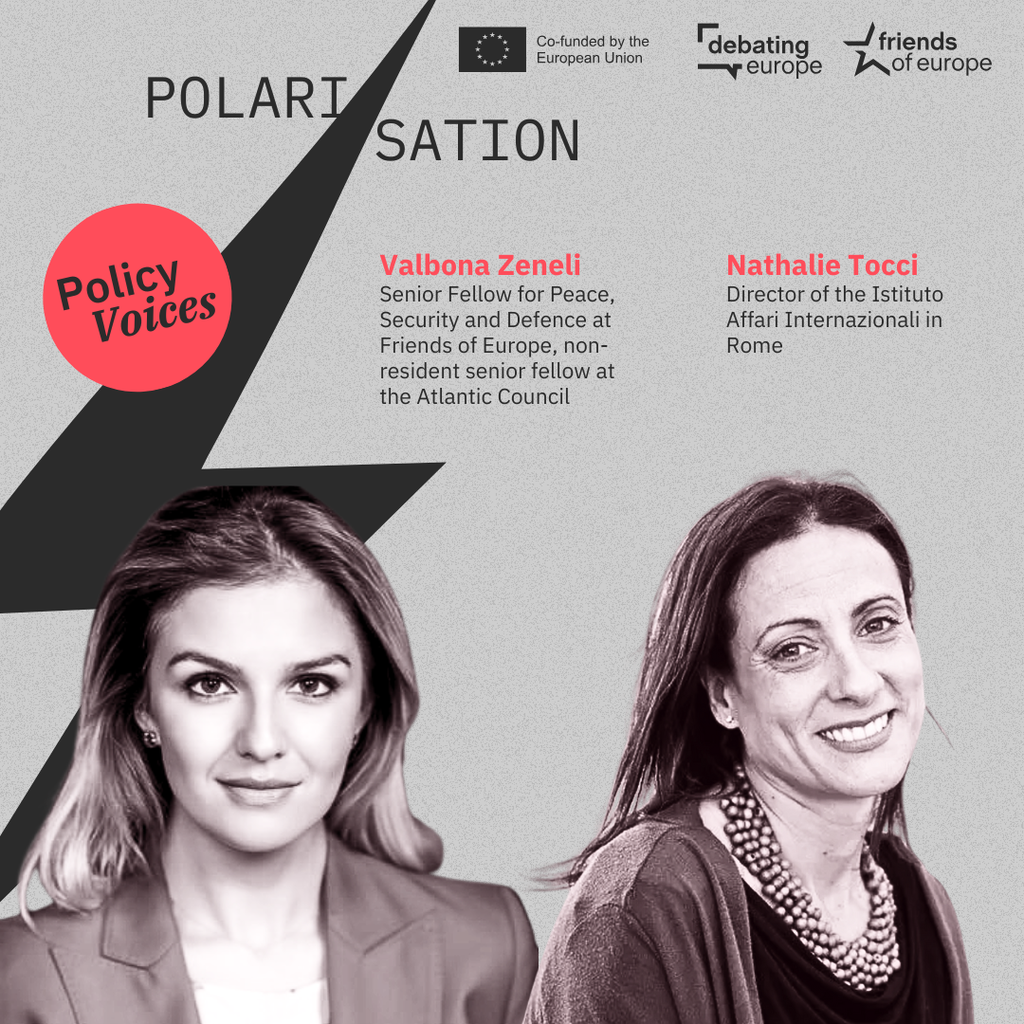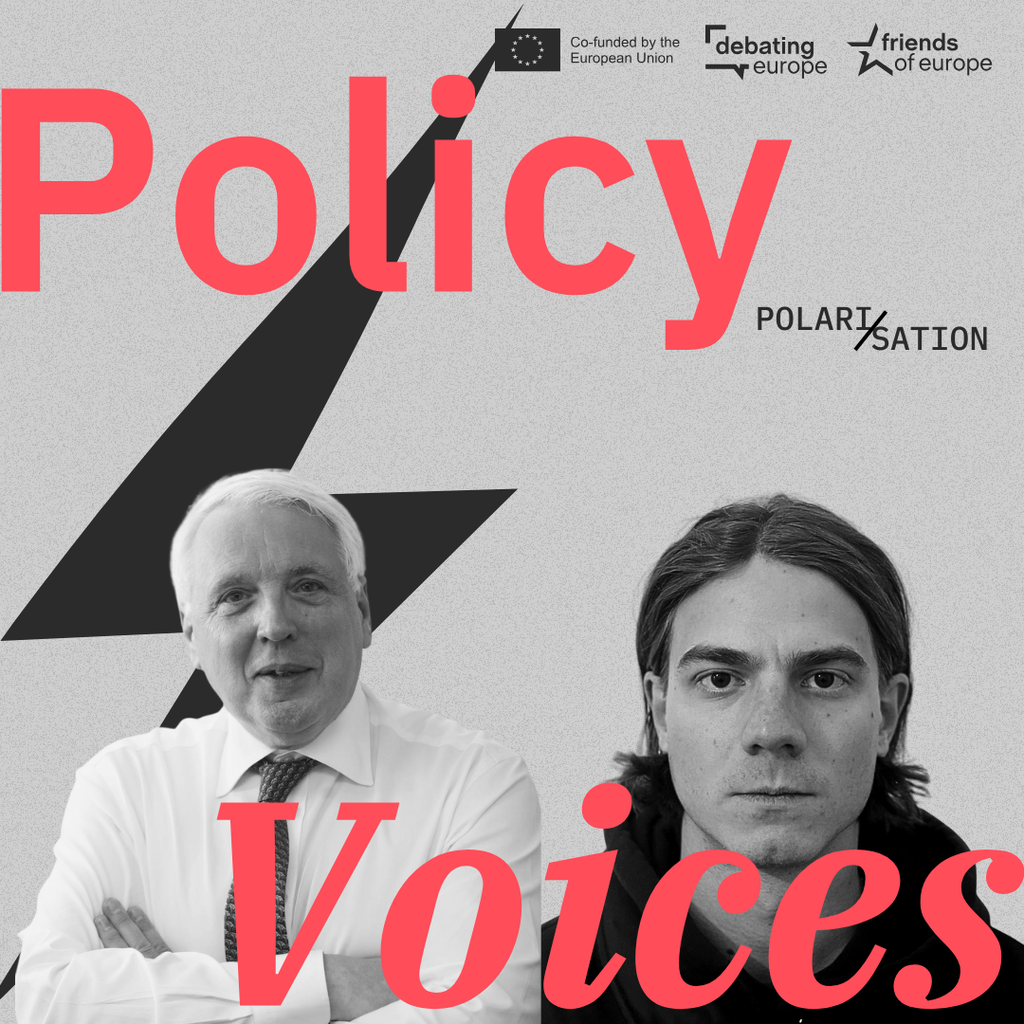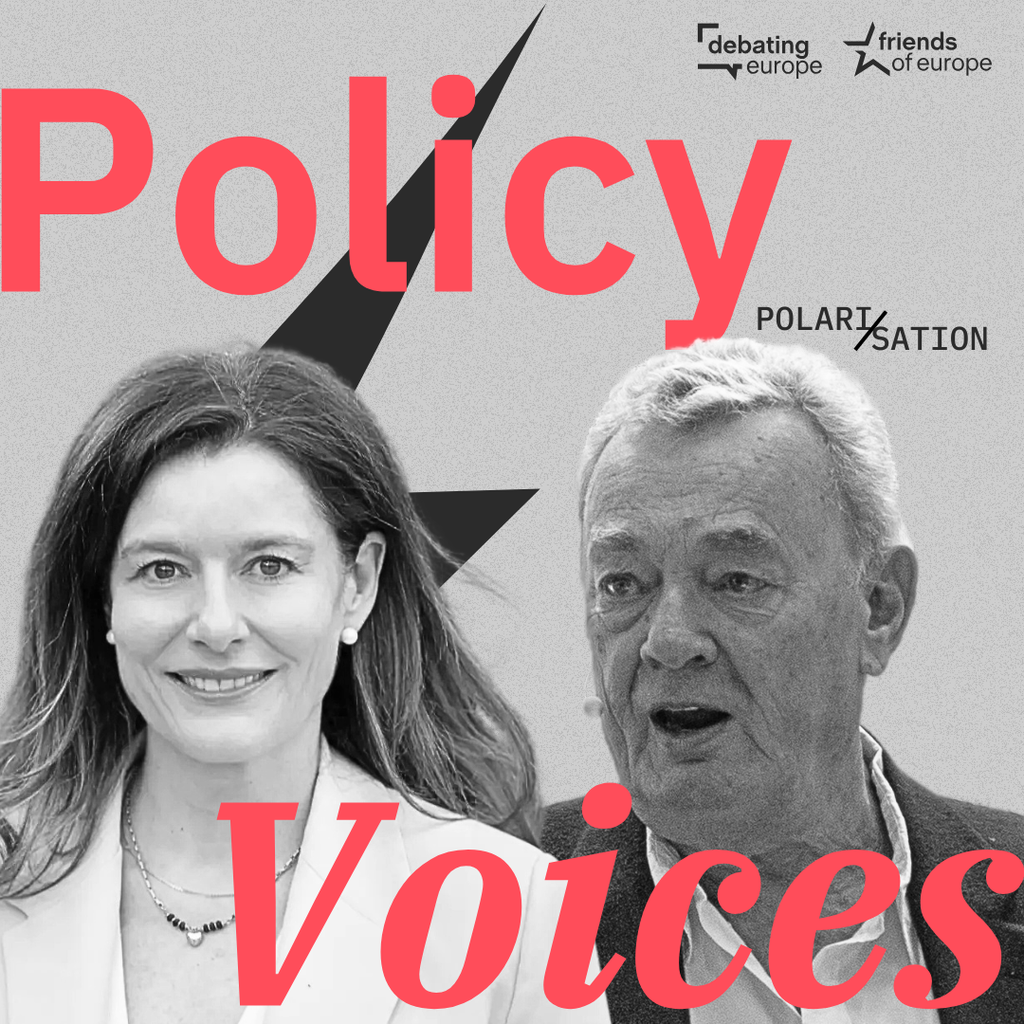Polarisation, disinformation, trust: do young French people think like…
Past event In person

- Area of Expertise
- Democracy
Peace, Security & Defence

Senior Fellow for Peace, Security and Defence at Friends of Europe, and former Deputy Assistant Secretary General for Emerging Security Challenges at the North Atlantic Treaty Organization (NATO)
The EU’s Lisbon Treaty of 2009 describes the vocation of the EU to form “an ever closer union” of its member states. It might just as well have spoken of ‘an ever wider union’. The original six countries which signed the Rome Treaty in 1958 to form the original European Economic Community (EEC) may have seen the rationale of the European project as reconciling France and Germany after the devastating European wars of the first half of the 20th century. Yet the success of this economic grouping inevitably attracted others who felt that staying on the periphery was holding them back. So, in 1973 the six enlarged to nine when the United Kingdom, Denmark and the Republic of Ireland joined the EEC. Their motivation was essentially economic rather than political; to gain greater tariff-free access to the EU market and boost their languishing trade and living standards. They were for long half-hearted members. The UK was obsessed with its sovereignty and the feared encroachment of the EU on its national laws and customs as well as the authority of the UK Parliament at Westminster. Ireland worried about EU interference with its traditional values, such as the role of the Catholic Church in society and its ability to take advantage of low business taxes to attract inward investment; and Denmark was also reluctant to advance beyond political integration. It was only in 2022, and after Russia’s invasion of Ukraine, that the Danes held a referendum to finally reverse their opt-out from the EU’s security and defence activities. Most famously, Denmark voted in another referendum to reject the EU’s Maastricht Treaty in 1992 and Ireland rejected the EU’s proposed constitutional reforms in the first Lisbon Treaty in a referendum of its own in 2008. After some fixes and changes, these treaties eventually went ahead but Denmark and Ireland had indicated that, whatever their leaders might think, the voters would not accept the transfer of more power from Copenhagen or Dublin to Brussels. So, although the EU widened and expanded its intra-block trade, operating budget and internal market, its institutional deepening and political integration were pushed a big step backwards.
Now, fast-forward to the 1990s and the end of the Cold War. The countries of Central and Eastern Europe, newly liberated from the yoke of Soviet oppression, saw in the EU the very antithesis of the Communist system that had been imposed on them after 1945. Thus, their motivation to join the EU came from a desire to overcome the division of Europe and to align themselves with Western liberal values. As states with no voice over their security arrangements or economies within the Soviet-dominated Warsaw Pact and Comecon, they were also seeking a seat at the table where key issues would no longer be decided behind their backs or over their heads. Of course, they were also interested in economic modernisation and access to EU regional and structural funds, and to the largesse of the Common Agricultural Policy (CAP). Yet the countries of Central and Eastern Europe also knew that economic modernisation and bringing their living standards within range of the EU average would take decades rather than years. In the meantime, joining the EU would enable these countries to recover a national identity and escape from the spheres of influence and buffer zones where traditional European great power politics had generally consigned them. They did not appreciate when the then French president, Jacques Chirac, told them in 2003 that they had missed an opportunity to “keep quiet” after they vocally supported the US war against Saddam Hussein of Iraq. The United States and the UK were notably supportive of the EU’s enlargement to Central and Eastern Europe precisely because they believed that the Eastern Europeans would be less protectionist and more Atlanticist in their outlook than Paris or Berlin. Something that the then US defence secretary, Donald Rumsfeld, famously described as “New Europe” versus “Old Europe”.
Even six rounds of EU enlargement up to now could not succeed in bringing all of Europe under the umbrella of the EU institutions
The EU responded to this geopolitical imperative by also seeing enlargement in the same strategic terms. The bloc could not turn its back on European countries that shared its values and had shown this in massive popular protests against the communist regimes in 1989. The new member states might be poor for the most part but other states in Europe that were richer – such as Sweden and Finland – were also in the queue to join the EU, and their contributions could help to offset the funds that Brussels would be redirecting to Warsaw or Budapest. Yet more EU member states meant more geopolitical weight for the Union on the global stage. The new members were also willing to accept the acquis communautaire, the sum total of all the EU laws, rules and regulations that had been adopted up to their accession date. They would accordingly, it was held, not demand the policy opt-outs or the budget rebates or go slow on EU reform and new constitutional treaties in the same manner that had long-bedevilled relations between the Eurocrats in Brussels and the Eurosceptics in Dublin and Copenhagen – but above all London. There were other compensations too. The countries joining the EU after the collapse of the Berlin Wall applied to join NATO as well, with the exception of Malta, Cyprus, Sweden and Finland. Yet the two latter countries eventually changed their policy of non-alignment and moved into NATO as well after Russia invaded Ukraine in February 2022, although this process is still not quite complete in the case of Sweden, with Türkiye and Hungary still needing to complete their parliamentary ratification. Thus, the US very much paid the bill for the security of the enlarged EU. The process also unfolded at a time of peace and relative stability on the European continent. Russia, although not enthusiastic, did not try to deliberately frustrate the EU’s outreach to its former Warsaw Pact allies and indeed seemed to find EU enlargement more acceptable than NATO’s expansion, with the fear that US tanks and nuclear weapons would come closer to its borders.
Peace in Europe and a relatively passive Russia meant that enlargement quickly became a principal raison d’être for the EU. Securing democracy and preventing the countries of Central and Eastern Europe from relapsing into a grey zone with less security and stability became the new geo-strategic goal precisely because security on the EU’s eastern borders would best preserve the integrity of the Union itself. No one in Brussels saw an interest in a return to the inter-war period when the countries of this region were inward-looking and nationalist, constantly shifting their alliances and always at risk of being pulled into a sphere of influence of one of the great powers. So, rather than wait for the former Communist countries to fully meet every technical standard and legal condition for EU membership, the EU’s leaders decided to go for broke and embrace at once as many of the candidate countries as possible while the geo-strategic landscape remained favourable. After all, the US was still willing and able to bankroll NATO, which meant that security was taken care of. The EU could focus on what it did best: economic alignment, structural reforms and infrastructure upgrades. The so-called ‘Big Bang’ enlargement of 2004 brought in 10 new member states in one full swoop – namely Poland, Hungary, the Czech Republic, Malta, Slovakia, Slovenia, Cyprus and the three Baltic States. Romania and Bulgaria were added in 2007 and Croatia became the most recent EU member in 2013. This haste did not always serve the EU’s best interests. It ensured that even during political and economic crises that shook the EU to its core, EU officials had to spend half of their time dealing with the problems of non-member states to their east. Tackling thorny questions like the EU’s role in defence, as the US looked more to Asia and the Middle East; or tax harmonisation, completing the single market in finance and services; or the EU’s role in health and pandemics; could be left for another time. The new member states and the 1980s intake in the form of Greece and Spain or the 1990s enlargement to Austria, Sweden and Finland also had their weaknesses. Greece cooked the books in order to join the common currency, the euro, and then had to be saved from financial collapse and being forced to quit the euro by the EU and IMF following the banking crisis of 2008. Unpitying austerity was imposed on the Greek population. Grexit was a fear long before we spoke of Brexit. Spain had its constitutional crises as Madrid clashed with separatists in the Basque Country and Catalonia. Austria flirted with right-wing populism long before many other EU states. Bulgaria and Romania suffered from high levels of corruption and less-than-perfect elections. Organised crime was a particular problem in Bulgaria still subject to a good degree of Russian influence. Shady business practices and old Soviet-style industries, militaries and intelligence services were a problem elsewhere. Cyprus became renowned for tolerating money laundering. Yet there was a sense that these lapses could be remedied over time. Following widening, the Union could go back to deepening. The 19th century Italian nationalist writer, Massimo d’Azeglio, once proclaimed: “We have made Italy; now we must make the Italians”. The EU could have rephrased it as: “We have made Europe, and eventually we will make good Europeans”.
With nearly 50 countries comprising modern-day Europe, even six rounds of EU enlargement up to now could not succeed in bringing all of Europe under the umbrella of the EU institutions. Norway and Iceland flirted with joining and then decided against it. Greenland, which is a member on account of its union with Denmark, departed in 1985 after 53% of the population voted in a referendum in 1982 to withdraw following a dispute over fishing rights. In the biggest reversal of all, the UK opted for Brexit in a referendum held in 2016. The UK had always been a half-hearted member of the EU. It sent only a junior Treasury official to the launch event held in Messina in 1955 and was always wary of the EU’s aspirations to go beyond a mere trade bloc. London demanded a multi-year budget rebate, refused to join the euro currency and the Schengen free movement area, opposed many EU Commission directives on workers’ rights and labour standards and was lukewarm towards the EU’s role in defence fearing that it would undermine or at least duplicate NATO. London frequently applied the brake to EU attempts at further political and economic integration, such as tax harmonisation or a banking union. Yet the UK was also the world’s sixth largest economy, a military and nuclear power with a permanent seat on the UN Security Council, a country with an important science and technology base and a significant net contributor to the EU budget. In short, a difficult partner but one that an EU enlarging mainly to poor and insecure countries needing a strong anchor could ill-afford to lose. Yet these failed enlargements at least demonstrated that contrary to the Warsaw Pact or other Soviet groupings, the EU was at least an institution that European countries were free to join, and free to leave, whether doing so was in their national interest or not.
The EU cannot reject countries and populations that share its values and want to be part of its community
At the same time, the EU was keen to expand its influence and leverage in those countries remaining on its periphery. It could not do much for Kosovo as five EU member states refused to recognise Kosovo’s independence. Yet, elsewhere, Brussels invented a Neighbourhood Policy succeeded by an Eastern Partnership to bring countries in the Western Balkans as well as Ukraine, Georgia and Moldova into its political and economic orbit. The Western Balkans countries had been offered the prospect of EU membership at an EU summit in Thessaloniki in 2002. It was an incentive for them to move on from the Yugoslav wars of the 1990s and to reform their institutions and economies, aided by a new regional EU Bank for Reconstruction and Development. Step by step the EU opened leisurely membership negotiations with Türkiye, Serbia and Montenegro, and finally after many delays and frustration, Albania and North Macedonia were awarded EU candidate status and the possibility of starting negotiations on the EU’s 35 individual membership chapters once they had fulfilled a number of conditions. Candidate status was not forthcoming for Ukraine, Georgia and Moldova, despite the first two countries being promised NATO membership at an unspecified future date at the alliance’s Bucharest Summit in 2008 – a pledge that 16 years later still seems far from being fulfilled. Yet in 2014, the EU did go so far as to negotiate a Deep and Comprehensive Free Trade Agreement with Ukraine. This had the somewhat tragic merit of inducing Russia to come off the fence and make clear in the most brutal manner its opposition not only to NATO but also to the non-military EU encroaching on the former Soviet space – henceforth declared by Moscow to be an existential security perimeter for Russia. The Kremlin responded by illegally annexing Crimea and sending its troops into the Donbas. The rest as we know is history but, to its credit, the EU did not use the pretext of war in Ukraine to jettison the Deep and Comprehensive Free Trade Agreement with Kyiv. Even in wartime, it was implemented, making it impossible for Russia to bully Kyiv into joining its Eurasian Union. Moving ahead in wartime was a useful exercise in what was to come later, after Russia’s second and much larger invasion of Ukraine in February 2022.
Fast forward again and we are now on the cusp of the EU’s greatest round of enlargement and most significant challenge to date. Last week, the Commission published its advice (Avis) according to which the European Council of heads of state or government should decide at their December meeting to open membership negotiations with Ukraine, Georgia, Bosnia Herzegovina and Moldova in addition to continuing them with the other six candidate countries. If all join, it will add some 160mn new citizens to the EU population. Moreover, there were some surprises in this proposal. Not so much regarding Ukraine as it is commonly seen that the path to EU membership is crucial to sustaining support for the Zelensky government and popular morale in what is turning out to be a long and grinding war of attrition against Russia. It is also an incentive for Kyiv to push on with reforms that will be as necessary for the country’s reconstruction after the war ends as for its longer-term EU membership. Yet what did raise eyebrows was the Commission’s recommendation to open talks with Georgia and Bosnia Herzegovina (BiH) despite the failure of these two countries to meet the very specific conditions set out by the Commission in its previous Enlargement Report. The Commission decided to prioritise geo-strategic reasons arguing that any further delay would only encourage the Georgian Dream – Democratic Georgia party in power in Tblissi to move closer to Moscow or the Republika Srpska in BiH under the leadership of the pro-Russian Milorad Dodik, challenge the Bosnian Constitution and threaten to withdraw the Serb entity from the Federation. Meanwhile, the Commission recommended that ongoing negotiations with all the existing candidate countries should continue to advance. It had predictably some harsh words to say about Türkiye but did not propose to suspend the negotiations with or revoke Türkiye’s candidate status. After all, Türkiye is the EU’s oldest aspiring member having asked to join the Union in 1964 and concluded a Customs Union with it in 1996.
European politicians need to revive and re-energise the debate on enlargement at a time when the whole process is running out of steam
We must now wait for the European Council in December to approve the Commission’s Avis and set a date for the opening of membership talks. It will not be straightforward. Hungary has announced that it will oppose Ukraine given a long-standing dispute between Budapest and Kyiv over the status of the Hungarian-speaking minority in western Ukraine. Slovakia may object too. Others may push back against the latitude shown to Georgia and Bosnia. Yet we have to also assume that the EU enlargement train has now left the station and that the EU Council will find a way to move forward. Opening long and complicated negotiations is not the same as actual membership and there are innumerable decision points, and blocking opportunities, along the way – for instance in closing individual negotiation chapters. The geopolitical factors are simply too strong. The EU cannot reject countries and populations that share its values and want to be part of its community. It cannot leave them in a perpetual grey zone subject to Russian interference and even domination. Russia might well move on to threaten the EU itself with military action. The EU knows that to stagnate is to go backwards and deny itself political and economic leverage over the countries on its eastern border. Promises have been made that need to be kept. The President of the EU Council, Charles Michel, has even suggested that the first batch among the 10 new candidate countries could join by 2030, which is amazingly ambitious as it means that negotiations would need to be completed by 2028 to allow sufficient time for ratification by the 27 EU member states. Much time in 2024 will also be lost as the EU holds its elections for a new European Parliament and the heads of its institutions. Four years for the negotiations seems hopelessly unrealistic and is a warning to EU officials to be open and honest about the tough questions that need to be answered and the enormity of the challenges that lie ahead. Going backwards may now be unthinkable but that does not make getting to the desired destination any easier. Six core challenges will define the future of EU enlargement and it is urgent that the Brussels institutions start today to develop a plan of action.
Firstly, how to keep the EU functioning and delivering every day for its citizens while so much time and energy will be spent by its leaders on the enlargement dossier? If EU citizens believe that the EU is focusing more on the welfare of non-member state citizens rather than their own, support for enlargement – which is never very strong in certain countries like France, the Netherlands or Italy – will plummet further. In the past, issues such as the EU’s role in defence and security, regulating new technologies such as artificial intelligence, controlling illegal migration, protecting key sectors like agriculture or trucking from foreign competition, could be put on hold as all the political energy was sucked into enlargement issues. But no more. Populists are much stronger today and exist in all EU member states. They will exploit any sense that the EU is not attuned to public concerns regarding secure borders, spiralling energy costs, environmental degradation and extreme weather events, unfair trade competition or the equitable distribution of COVID-19 vaccines. Already, Polish farmers have blocked the transport of Ukrainian grain arguing that the cheaper prices are undercutting their production and livelihoods. Polish truckers have blocked three border crossings with Ukraine to protest against an EU decision to grant Ukraine goods and services access to the EU internal market. These protests are a foretaste of things to come as French farmers lose EU subsidies under the CAP, and Romania and Bulgaria lose structural and regional infrastructure funds as the EU diverts money to upgrading the economies and living standards of the candidate countries. The reconstruction costs for Ukraine are priced at nearly $500bn and will be massively more than that by the time the war ends. The EU has already pledged $50bn for Ukrainian reconstruction and $15bn for budgetary support to Kyiv. The EU’s High Representative for Foreign Affairs and Security Policy, Josep Borrell, has requested €20bn for the EU’s Peace Facility to collectively fund weapons supplies to Kyiv. This money is not linked directly to enlargement but to help Ukraine emerge intact from the Russian invasion. Unsurprisingly, the Commission has asked the member states for a revision to the current seven-year Financial Framework. Member states are dragging their feet but, manifestly, EU enlargement and the future functioning of the Union are not going to work with just 1.3 % of national GDPs being transferred to the EU budgets. Massive sums will be required, for several years.
The challenge will therefore be to persuade existing EU citizens to see enlargement as good for them and not only good for future EU citizens. Governments will need to be honest about the undoubted heavy costs but get out into the field to take on the populists and make a convincing case. Hiding behind rosy scenarios and over-optimistic predictions is a recipe for long-term disaster. The problem is that the debate is asymmetric. Enlargement will bring short-term economic benefits to the future members but only long-term and more hypothetical benefits to the current EU members – as well as less tangible things than money in the pocket, such as security, values or the EU’s weight on the global stage. So, how do you win an argument in these conditions? The additional problem here is that European politicians need to revive and re-energise the debate on enlargement at a time when the whole process is running out of steam. There has been no new EU member for over a decade. The previous Commission president, Jean-Claude Juncker, declared that the EU should pause the process for at least 5 years. Negotiations with Türkiye had stopped and were proceeding at a snail’s pace with Serbia and Montenegro. Other aspirants in the Western Balkans did not seem to be making progress with the rule of law, fighting corruption and organised crime, or reforming their political systems and economies either. French President Emmanuel Macron insisted during his first term that the EU needed to consolidate and deepen first – for instance in foreign and defence policy, or through completing the internal market or a banking union to underpin the euro – before it widened further. With enlargement fatigue so prevalent among the voters, how does the EU turn the ship around and rekindle some of the old post-Cold War enlargement enthusiasm?
The second challenge is to balance the political and technical aspects of EU integration. The Union requires alignment with thousands of pieces of EU legislation. The acquis communautaire has evolved over six decades and now covers hundreds of thousands of pages of rules, regulations and directives on everything from car tail lights to the composition of chocolate. It is easy for both the Commission and the candidate countries to become trapped in these detailed and legalistic negotiations and to lose sight of the geopolitical dimension of EU enlargement. The process of bringing candidate countries closer to EU policymaking and to its foreign policy and security objectives must begin as soon as accession negotiations begin. It cannot be permissible for a candidate country like Serbia to carry on the technical talks while refusing to go along with EU sanctions against Russia for its invasion of Ukraine, and increasing its dependency on Russia and China for weapons, technology and energy supplies. Serbia has also refused to engage constructively with Kosovo on the normalisation of relations and makes periodic attempts to threaten its neighbour with military buildups on its northern border and create Belgrade-dominated parallel structures in northern Kosovo. A prospective EU member cannot take a pick-and-choose approach to EU integration and have a foot in both the liberal international camp and the camp of the authoritarians at the same time. It has to share EU values and behave and act as an EU member. So, the technical and political tracks of enlargement cannot run along separate parallel lines but need to proceed in lockstep, support each other and be assessed by the European Council, Commission and Parliament together. One major question here concerns the European Political Community (EPC) proposed by President Macron to facilitate the political dialogue between the EU member states and the rest of Europe from the Atlantic to the Caucasus. The EPC has held three summits thus far and has discussed pan-European issues such as regional conflicts, energy security and illegal migration. The problem, however, is that it hasn’t yet developed a common agenda, and some leaders, such as Turkish President Recep Tayyip Erdoğan or Azerbaijani President Ilham Aliyev, have stayed away precisely to avoid discussing regional conflicts – in this case, Nagorno Karabakh. An additional problem is that the UK does not see the EPC as an EU-linked institution but as something separate and may disengage if it believes that the Community is essentially a waiting room for enlargement.
In third place is the challenge of managing the internal and external aspects of EU enlargement simultaneously. Thus far, countries joining the EU have been bolted onto the existing institutional structures taking their allocation of seats in the European Parliament and sending their Commissioner to Brussels in the hope that they will be given a weighty portfolio. The new members go into the pot of population size that helps to determine a weighted majority in EU voting where the consensus rule does not apply. So far, the EU has gone from 6 to 27 member states without the need for too much internal restructuring. The pie of regional, structural and agricultural funds has been redistributed and more thinly across more member states. The EU has long spoken of its ‘absorption capacity’ – which can also be understood as ‘limits’ – without defining exactly what this means. Is it that it cannot afford to admit new members or that it cannot admit more newcomers without major internal reforms? The prevailing view is that it is the second case and with nearly 40 rather than 30 members institutional reform is unavoidable so that the Union can continue to make decisions and function effectively. This debate has several angles from whether the newcomers have the right to a Commissioner to changing the voting rules and abolishing the consensus rules in favour of majority voting across the board to finance and the ability of the EU to impose its taxes and raise money on the capital markets. The debate has also embraced the structure of the Union with France and Germany going back to old ideas regarding a multi-tier or multi-speed Europe where member states could have different forms of integration and membership and different obligations and privileges attached to each level. This model might encourage the UK to seek a new form of association with the EU built around membership of the Customs Union and internal market, limited budget contributions and cooperation on foreign policy, security and defence. The challenge for the EU will be to define the pace and scope of institutional reform which is bound to be a sensitive and difficult debate touching the core of national interests. Does the EU change its structures, rules and procedures in anticipation of all 10 candidates eventually joining – as well as perhaps Switzerland, Norway, Iceland and the UK taking a second look? Or does it adopt a wait-and-see approach to see if enlargement indeed goes ahead? There are many in Brussels and in the member states who are sceptical that the EU will be able to go through with all its promises and will be forced to backtrack as neither it nor the majority of the current candidates will ever be truly ready. Or else, does it wait until the end of this next enlargement round and then debate institutional reforms with all the new members participating in the discussion and decision-making? Would this not make the EU dysfunctional and make a successful reform outcome even more unlikely? At all events, how will the two tracks of external and internal reform be coordinated and be made conditional on each other? Many observers believe that the EU’s member states need to look at the Union’s functioning even without the driver of further enlargement. They point to the backsliding of the existing members; for instance with the rule of law in Hungary and Poland, reversals on abortion and LGBTQIA+ rights, the suspensions of the Schengen zone of open borders, the inability to agree on an EU Migration Pact, Hungary holding up sanctions against Russia and support for Ukraine, and the way in which states are violating EU budget rules or rules on state aid as they dole out subsidies to their prized national companies. In this view, the EU must protect the internal market against erosion and put its own house in order now rather than tie internal reform to a distant and uncertain enlargement process.
Fourth is the issue of progressive integration. As the process of EU enlargement will be protracted and difficult with all 10 countries unlikely to be able to join as a group at the same time, contrary to what happened in 2004, the EU will need to give the candidates some of the benefits of full EU membership before they have formally completed the accession process. This will help them to stay motivated and move faster towards ultimate accession by adopting many of the EU’s norms and standards and consolidating a basis on which to build further. To some extent, this concept of progressive integration has been followed by the EU for decades already in the Association and Stabilisation Agreements that it has concluded with its neighbours. For instance, some like Switzerland and Norway have access to the internal market and freedom of movement. Even the UK concluded a Trade and Cooperation Agreement upon its departure from the EU in 2020. The challenge now will be to introduce these incentives to reform and meet EU standards into the accession process itself so that the rewards for progress are clear and tangible and populations in the candidate countries see the benefits, such as market access or labour and educational access, in return for the sacrifices that meaningful reforms can entail in the short term. Which benefits of membership should the EU grant at which stage of the reforms, neither being unnecessarily generous or harsh, and in a way that expedites the capacity of candidate countries to meet all 35 chapter requirements? This is a complex issue that the EU will need to grapple with.
To succeed with this round of enlargement the EU will need to widen and deepen at the same time, and not in subsequent stages as on previous occasions
Finally, EU standards and implementation. In the past, the Commission has been criticised for not following up with sufficient rigour on the actual implementation of EU-required legal changes and institutional and economic reforms. It has been content to tick the boxes of reforms that candidate countries declare that they have carried out, at least in terms of formal adoption. But everything depends upon actual implementation and stringent monitoring that new laws are being followed and the reforms are working. As the EU gets bigger, it will only be able to function if the rules are taken seriously by all the member states and applied consistently across the Union. So, the culture of observance of EU law and rules is one that the Commission has to inculcate into the candidate countries from the outset of the negotiations. This task would admittedly be easier if the existing member states would themselves set a better example. At the same time, the EU needs to establish a credible and trusted verification mechanism to monitor implementation and call out lapses or backsliding. This type of rigour will help to restore public confidence in the enlargement process in the existing EU member states. As President Macron and some other EU leaders have suggested in the past, this process has to be reversible in the case of those candidates whose accession stagnates indefinitely for political or technical reasons. At a certain point – and Türkiye and Serbia are often cited in this regard – the EU has to declare ‘time-out’, revoke the candidate status and propose an alternative form of association. In the case of Türkiye, an enhanced form of the current Customs Union has been an option advocated by many EU watchers.
Across from where I live in London, a West End theatre is staging a revival of Mamma Mia with the sub-title “Here we go again”. Observers of EU enlargement may well believe that we are about to repeat previous exercises in bringing onboard new members and that this is business as usual – love it or hate it. But this time around, the stakes are far higher. The EU has not before enlarged at a time of war and in a geopolitical space that is hotly contested by an authoritarian great power rival, in this case, Russia. Moreover, Russia has been prepared to use force on a major scale to stop the EU from moving ahead and is seeking to undermine it through a host of hybrid warfare campaigns, and political interference and disinformation tactics. To succeed with this round of enlargement the EU will need to widen and deepen at the same time, and not in subsequent stages as on previous occasions. Internal changes may require new EU treaties and referendums in certain member states which we know is a hazardous exercise. And the EU will need to deliver on the needs for security, protection and prosperity of its existing citizens and those of its future citizens at the same time. The image of redesigning the plane as you fly seems appropriate here. Above all, the whole process, when it is ultimately completed in several years, has to lead to a stronger EU on the global stage, able to advance its values and interests and stand up to the headwinds coming from Russia, China and even a Trump-led US in a more competitive and confrontational world. From a conceptual point of view, an EU of 40 member states is both an asset and a weakness as the EU strives to become a forceful geopolitical player. Never before has the EU faced a challenge on this scale, and never before have we needed inspirational EU leadership to impose strategic direction and coherence on this complex process. It is not just about the future functioning of the EU, but about the future security of Europe and indeed the survival of European civilisation itself.
The views expressed in this #CriticalThinking article reflect those of the author(s) and not of Friends of Europe.
Past event In person

Past event In person - Prato, Italy

Past event In person

Next event In person & Livestreamed





Stay informed
We use cookies and similar technologies to adjust your preferences, analyze traffic and measure the effectiveness of our campaigns. Learn more about our privacy policy.